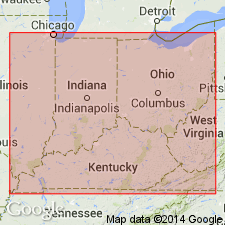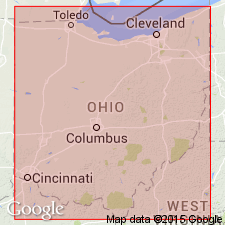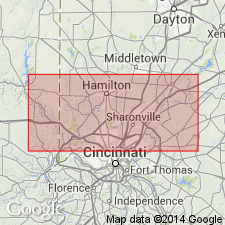
- Usage in publication:
-
- Fort Ancient division
- Modifications:
-
- Named
- Dominant lithology:
-
- Limestone
- AAPG geologic province:
-
- Cincinnati arch
Summary:
Name Fort Ancient division applied to lower part of Waynesville bed of Richmond formation. Characterized by abundance of DALMANELLA JUGOSA, with exclusion of all other brachiopods and corals considered characteristic of the Richmond. The assemblage of lamellibranchs suggests that Fort Ancient division of Waynesville bed belongs with upper part of Arnheim rather than with Clarksville and Blanchester divisions of Waynesville bed. [Is treated by the USGS as top beds of Arnheim formation. According to E.O. Ulrich and C. Butts , the beds more appropriately belong to Arnheim than to Waynesville, from which they are separated by an unconformity. Later reports of Foerste, however, describe an unconformity at the base of his Fort Ancient division.] Age is Late Ordovician.
Source: GNU records (USGS DDS-6; Reston GNULEX).

- Usage in publication:
-
- Fort Ancient member
- Modifications:
-
- Revised
- AAPG geologic province:
-
- Cincinnati arch
Summary:
Unit shown on generalized section of Ohio as basal member of Waynesville formation. Underlies Clarksville member; overlies Oregonia member of Arnheim formation. Age is Late Ordovician.
Source: GNU records (USGS DDS-6; Reston GNULEX).

- Usage in publication:
-
- Fort Ancient Member
- Modifications:
-
- Overview
- AAPG geologic province:
-
- Cincinnati arch
Summary:
Fort Ancient Member of Waynesville Formation shown in stratigraphic column of southwestern OH. Overlies Oregonia Member of Arnheim Formation; underlies Clarksville Member of Waynesville. Age is Late Ordovician (Cincinnatian).
Source: GNU records (USGS DDS-6; Reston GNULEX).
For more information, please contact Nancy Stamm, Geologic Names Committee Secretary.
Asterisk (*) indicates published by U.S. Geological Survey authors.
"No current usage" (†) implies that a name has been abandoned or has fallen into disuse. Former usage and, if known, replacement name given in parentheses ( ).
Slash (/) indicates name conflicts with nomenclatural guidelines (CSN, 1933; ACSN, 1961, 1970; NACSN, 1983, 2005, 2021). May be explained within brackets ([ ]).

